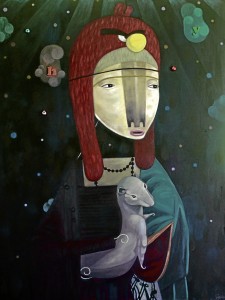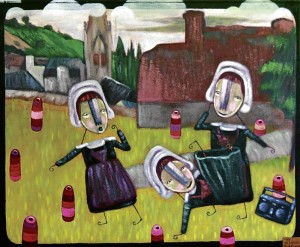
In 2007, Farley del Rosario delighted the art scene with a teasing collection which drew inspiration from timeless masterpieces, his playful renditions more takeoff than tribute.
This year, Del Rosario is at it again in a follow-up of the series, “Impostor in Poster, Martial Rule, and Monsters.”
New in the second installment are sculptures and an editorial mixed-media piece that was actually meant for a martial-law exhibit but was left unfinished when a typhoon hit Del Rosario’s hometown.
The artist’s naïf figures are still spotlighted as they take the place of characters in his works, but are tweaked in a relatable and amusing fashion—the subtle use of familiar elements that scream pop culture.
Del Rosario also spoofs and gives Juan Luna’s “The Parisian Life (Interior d’un Café)” an out-of-this-world edge through the mixed-media piece “Martian Life.”
In the original painting, a somber lady looks on as she sits alone in a café. A group of well-dressed gentlemen immersed in a discussion stay a table away in the background, while one of them seemingly glances at the young woman.

Del Rosario’s version portrays the same man still stealing a peek at the individual seated alone, but his curiosity would be clearer this time. Replacing the lass is a miserable-looking extraterrestrial life form—Tim Burton’s depiction of a Martian, seen in the 1996 film “Mars Attacks!” The work might insinuate man’s cluelessness to the female mystique. Here it turns out women are not actually from Venus but from Mars.
Also, unlike Luna’s painting, which is in earth tones and muted pink and lavender, Farley’s abstract pops of red and textured yellow are scattered on the canvas. In the background are the men, who still sport the same dapper wear but whose faces have been turned into those distinct cartoon-like ovals with prominent, straight noses and slanted eyes.
Another movie-inspired parody is his take on Whistler’s “Arrangement in Grey and Black, Portrait of Painter’s Mother.” In place of the elderly woman’s face is the image of Jigsaw, the killer in the 2004 horror flick “Saw.” The mixed-media piece is titled “Jigsaw Puzzle.”
In some of the works, Del Rosario purposely downplays the comical changes by the pieces’ titles.
His “Break-Dancing” is inspired by “Breton Girls Dancing” by Gauguin. At first glance, the scene appears much like the original. A closer look would show that one of the girls is on the ground, has her legs lifted in midair, and is in the middle of a break-dance showdown. Beside the break-dancers is a hip-hop boom box.
Da Vinci adaptation
The artist’s adaptation of Da Vinci’s “Lady with the Ermine” seems faithful to the striking portrait, until one notices that the lady’s headdress is a red Angry Birds bonnet.
The mixed-media “Lady in Angry Bird Hat” is a darker version of the piece that inspired it, but with Farley’s figures the piece is given humor. Even the weasel’s front paws turn into Del Rosario’s signature extremities-turned-single curls.
The largest, “Playground of the Masters,” is a wonderful oil-on-canvas melting-pot of Del Rosario’s inspirations in painting. In the piece are the styles, genres, characters and elements of eight masters and their respective masterpieces; and Del Rosario’s own imprint.
The scene’s foreground seems a cross between any wonderland and the seabed, with plant life similar to interlocking trees and anemone-like creatures spread across the picture. Instead of a full crop of leaves on top, the trees appear to have smooth, open husks. In these cups sprout characters from well-known artworks. Viewers will have a ball identifying the masters featured in the painting. The work is a fitting representation of the series.
One of the sculptures, “Tribute to Warhol,” looks just as it sounds. It honors the modern master and takes to heart Warhol’s “Campbell’s Soup Cans,” a compilation of 32 canvases bearing the image of the Campbell’s Soup can.
The sculpture is meant to be a portrait, with Warhol’s face on the head and his body a Campbell’s Soup can—painted in Farley’s trademark naïf, up to the hands, which are made of tiny hooks.
Another tribute is to Magritte and highlights the artist’s “Son of Man.” In his “Tribute to Magritte,” Del Rosario uses an old octavina as his canvas and sets the image’s green apple right smack in the middle of the rondalla instrument’s sound hole, leaving the fruit dangling about.
What could be the collection’s oddball is the martial-law piece, “M.” The entire work is done on a recycled guitar body, with the middle cut open so that the instrument’s interior could serve as canvas to its background—a calm mountain range. Seated on the edge of the guitar’s bottom is a miniature Ferdinand Marcos, who looks as if he is in the middle of a serenade with an even smaller guitar in hand.
An assortment of elements sticking from and hanging about the instrument embodies the three Gs that plagued the country during the dictatorial rule: guns, goons and gold.
“Impostor in Poster, Martial Rule, and Monsters” opens today, Dec. 3, at Canvas Gallery and Garden, 1 Upsilon Drive Ext., Alpha Village, Diliman, QC. Call 6247551.

